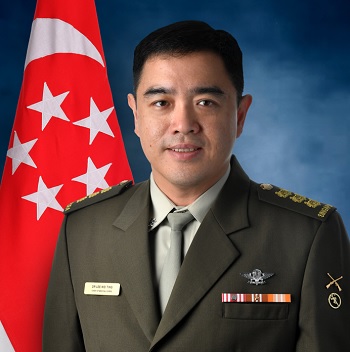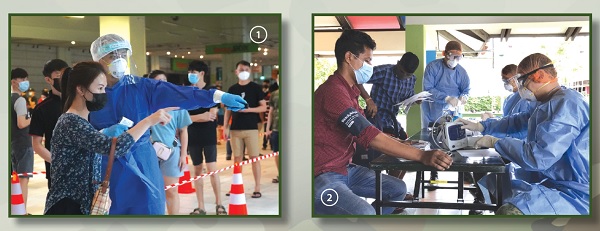The COVID-19 pandemic highlighted the critical role of military medical organisations in supporting national whole-of-government (WoG) public health efforts to bring the pandemic under control, while maintaining the health and readiness of its own forces. In the spirit of commemorating 55 years of National Service, Dr Ivan Low (IL) speaks with COL (Dr) Lee Wei Ting (LWT), Chief of Medical Corps (CMC), in this interview piece to find out more about how the military medical corps have supported civilian medical organisations through the COVID-19 pandemic. COL (Dr) Lee also sheds light on the challenges and lessons of the past two years.

IL: Welcome to SMA News, COL (Dr) Lee. Could you tell us more about yourself, and perhaps something that your colleagues don't know about you?
LWT: I took over as the Singapore Armed Force's (SAF) 12th CMC in January 2022. In my role as CMC, I look after the healthcare needs of the SAF. Firstly, I am responsible for the health of our servicemen and servicewomen. However, beyond the provision of healthcare, we are increasingly focusing on health promotion and disease prevention. Secondly, I work closely with the Army, Air Force and Navy to sharpen our operational medical capabilities, increasing the survivability of our casualties in operational and combat situations. Thirdly, in this resource-constrained world, it is my job to advocate for the SAF, and to seek partnerships with healthcare clusters and the industry.
I am an orthopaedic surgeon by training and continue to practise in the National University Hospital. I'm married to Dr Leong Shu Yee, whom I met on the day of our Medicine admissions interview. We have two kids, aged 15 and 13 this year. They bring me much joy, but also drive me up the wall sometimes.
Something my colleagues do not know about me is that I had not wanted to be a doctor growing up. In fact, I wanted to be a horticulturist. I was very interested in hydroponics and horticulture in junior college, and I was thinking of furthering my studies in that field. However, I could not find any available courses – one thing led to another, and here I am after 20 years. I am still passionate about horticulture, and I hope to work for NParks one day, after I retire.
SAF's role in the fight against COVID-19
IL: We understand that the SAF Medical Corps participated and led various arms of national COVID-19 operations over the past two years. How were you involved in the national (or international) fight against COVID-19?
LWT: When the news first broke about this unknown outbreak in China, many of us were worried as the shadow of SARS still hung over us. In the initial stages, the SAF Medical Corps looked primarily inward – our focus was on force health preservation, and to ensure that the SAF maintained its fighting strength and operational abilities. However, when the virus arrived on our shores in 2020, rapidly spreading and threatening our public healthcare system, the SAF began to get more involved in WoG operations – starting with non-medical means such as face mask packing and distribution, and then the SAF Medical Corps' foray into the migrant worker dormitories.
I remember receiving a call on a Saturday night at 11 pm, asking me to report for a meeting the following morning. That was my first inkling that things were not going well. As I sat through the discussions about the situation in the dormitories, it really struck home how real the pandemic threat had become, that it was no longer just a remote possibility or a figment of our imagination. We activated the Medical Response Force, and within 48 hours, our medical teams were deployed to the dormitories, providing essential medical care and helping to identify new COVID-19 patients. We had another team that set up a Swab Isolation Facility that housed patients awaiting their COVID-19 PCR test results.
As the situation worsened during the circuit breaker (CB), requests for assistance continued to come in. While we were in the thick of the dormitory situation, there was a request from the Ministry of Health (MOH) to help establish and run a community care facility at Singapore EXPO to function as a form of step-down care for COVID-19 patients. A Tri-Service team comprising active servicemen and service women from the Army, Air Force and Navy, National Servicemen (NSmen) from our Army's Combat Support Hospitals and the Republic of Singapore Navy's Naval Ship Hospitals were activated for this task.
Shortly after the nation emerged from the CB, we managed to secure COVID-19 vaccines, and our focus shifted to vaccination operations, assisting MOH in providing a home vaccination service (including 20 NSmen-only teams) for less mobile individuals in the community. As the pandemic evolved, our needs changed, and in the recent Omicron waves, we deployed teams from all three services to emergency departments across the nation. We also helped to run COVID-19 treatment facilities for patients requiring a longer period of medical observation before they could return home.
I am fortunate to have very good men and women in the SAF Medical Corps who truly understand the importance of what we do. My job throughout the pandemic was to bring in the right people, ensure that they understood the mission, and to support the medical teams conducting the operations. This required coordination between many stakeholders within the SAF and other Ministries, in order to ensure that our people were able to provide the care that our patients needed.
Civil-military cooperation for COVID-19 operations
IL: There must have been many challenges, being a part of such a large and complex WoG pandemic response system. Were there differences in the views (eg, on public health policies) and practices (eg, healthcare processes, medical equipment) between civilian and military organisations? How were these differences reconciled?
LWT: Whenever different teams or individuals are brought together, they go through a "storming to norming" process. But given the rapidly evolving situation, there were few opportunities for us to do this. In the initial stages, it was very tense. There were no well-established protocols or processes to follow. We had to build trust, improvise a lot and make decisions with the limited information we had on hand.
In the end, we were united by our desire to see Singapore through this crisis. Each agency brought unique skill sets and knowledge to the table, and we complemented each other. We did not work in silo; rather, it was truly a whole-of-Singapore effort. It was a privilege to work with our civilian counterparts from MOH, Ministry of Manpower, other government agencies and non-governmental organisations. It was inspiring to see everyone working in tandem to help Singapore pull through this crisis.
IL: In the course of running COVID-19 operations, was there anything different about the way civilian and military medical leaders thought, or how their organisations were run? For public health operations, what do you feel that civilian and military health systems could learn from one another?
LWT: There were certainly differences in opinion. Looking back on the various operations that the SAF Medical Corps has been involved in during the pandemic, there has always been some tension. In my mind, this is to be expected. Everyone comes to the table with a different perspective, shaped by their expertise or experiences. For instance, the healthcare workers and public health professionals adopted a very scientific view of how the pandemic needed to be addressed, while the logisticians presented a view that focused on what was feasible, and the operation planners tried to piece it all together and sought to respond to the situation as it unfolded. There were areas where these perspectives were in sync, but also areas in which they were not. Fortunately, everyone understood the mission, and we were able to reconcile these differences and make compromises where required.
Another thing that I observed through the operations was everyone's ability to remain flexible and nimble in their planning. Nobody fell in love with their own plans. As the situation developed, various agencies were not afraid to voice out that the plans that had been made earlier may no longer be appropriate, or that earlier planning assumptions had been disproven. In this regard, we were able to find solutions quickly as everyone had this constructive mindset.
The SAF has a very systematic way of handling uncertain or complex situations; ie, our "battle procedure". It was quite useful as it helped us break down the situation into bite-sized issues that we could then tackle using multiple lines of effort. This "battle procedure" came up multiple times while working with our civilian counterparts and provided a common framework for all of us to rely upon.
Safeguarding national defence interests through the pandemic
IL: The SAF must have had its own national defence priorities through the pandemic. Could you tell us more about them and whether it was difficult to juggle contributing to WoG efforts while fulfilling the SAF's mission requirements?
LWT: Through the pandemic, there was never a compromise to the SAF's operational medical support and force health protection requirements, as there is a perpetual need to safeguard our national defence and sovereignty. It was difficult to meet the competing demands, and every request for support was thoroughly examined before a judgement call was made. So far, we have been able to balance both priorities, through the hard work of our people.
IL: What was your biggest takeaway or the most memorable thing from the past two years of COVID-19 operations? What are some lessons for military medical organisations from these experiences?
LWT: The pandemic has taught us that healthcare resourcing is a zero-sum game, and that no agency should operate in its own silo. My biggest takeaway from these operations is that the SAF Medical Corps is and must remain a part of the national healthcare system, and that both civilian and military healthcare agencies must remain integrated at all levels. At the operational level, this will facilitate interoperability, thereby building resilience to our healthcare system. At the strategic level, this will allow us to appropriately allocate our resources and sharpen our key areas of investment.
IL: This year marks 55 years of National Service in Singapore. It also marks the SAF Medical Corps' 55th Anniversary. Many of our readers are NSmen medical vocationalists – SAF medical officers, medics, allied health and ancillary service providers – do you have a message for them?
LWT: As a nation, we survived COVID-19 not only because of good healthcare infrastructure and early access to vaccines, but because of our people. Healthcare workers have given their all and have made many personal sacrifices over the past two years. It is because of their fortitude and determination that we made it through this crisis. The SAF's response to the pandemic was heavily supported by our full-time and operationally ready national servicemen – a "whole-of-NS" effort.
I am very proud of our NSmen and full-time NSmen for rising to the occasion during what was the first pandemic for most of them. There must have been a lot of trepidation about putting themselves and their families in harm's way, but our servicemen were able to put aside those fears and give their best to the operations. The pandemic brought out the best in our people and, looking back, I have even greater confidence that our medical vocationalists will continue to Seek excellence, Save lives, and Serve those in need.
